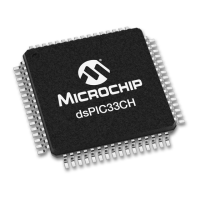dsPIC33/PIC24 Family Reference Manual
DS70005340A-page 54 2018 Microchip Technology Inc.
4.4 Disable Mode
Disable mode is similar to Configuration mode, except the error counters are not reset. Disable
mode is requested by setting REQOP<2:0> = 001.
The CAN module will not be allowed to enter Disable mode while a transmission or reception is
taking place to prevent causing errors on the CAN bus. The module will enter Disable mode when
the current message completes.
The OPMODx bits indicate whether the module successfully entered Disable mode. The application
software should use this bit field as a handshake indication for the Disable mode request.
The CxTX pin will stay in the recessive state while the module is in Disable mode to prevent
inadvertent CAN bus errors.
4.5 Debug Modes
4.5.1 LISTEN ONLY MODE
Listen Only mode is a variant of Normal CAN FD Operation mode. If the Listen Only mode is
activated, the module on the CAN bus is passive. It will receive messages, but it will not transmit
any bits. TXREQx bits will be ignored. No error flags or Acknowledge signals are sent. The error
counters are deactivated in this state. The Listen Only mode can be used for detecting the baud
rate on the CAN bus. It is necessary that there are at least two further nodes that communicate
with each other. The baud rate can be detected empirically by testing different values until a
message is received successfully. This mode is also useful for monitoring the CAN bus without
influencing it.
4.5.2 RESTRICTED OPERATION MODE
In Restricted Operation mode, the node is able to receive data and remote frames, and to
Acknowledge valid frames, but it does not send data frames, remote frames, error frames or
overload frames. In case of an error or overload condition, it does not send dominant bits; instead,
it waits for the bus to enter the Idle condition to resynchronize itself to the CAN communication.
The error counters are not incremented.
4.5.3 LOOPBACK MODE
Loopback mode is a variant of Normal CAN FD Operation mode. This mode will allow internal
transmission of messages from the transmit FIFOs to the receive FIFOs. The module does not
require an external Acknowledge from the bus. No messages can be received from the bus,
because the CxRX pin is disconnected.
4.5.3.1 Internal Loopback Mode
The transmit signal is internally connected to receive and the CxTX pin is driven high.
4.5.3.2 External Loopback Mode
The transmit signal is internally connected to receive and transmit messages can be monitored
on the CxTX pin.

